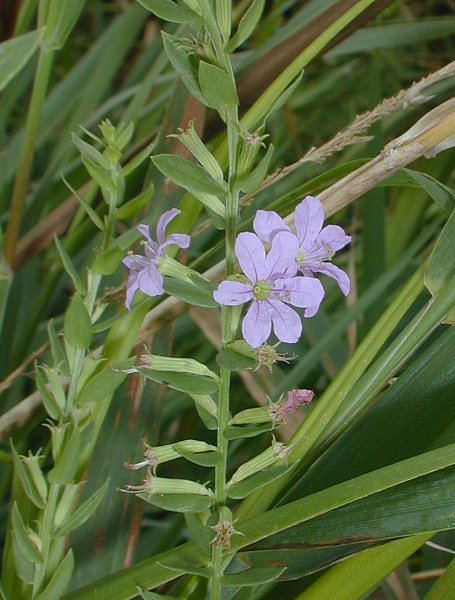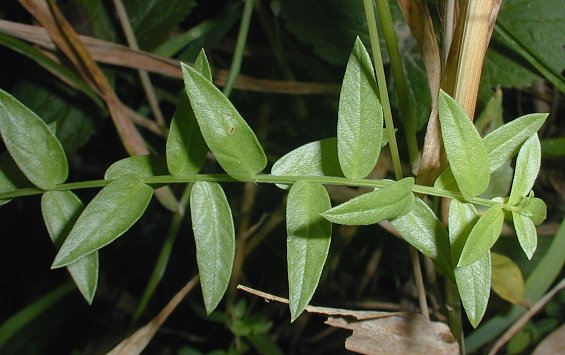Description: This perennial plant is up to 3' tall, branching occasionally from the lower half of the central stem. This central stem is strongly winged and hairless. The leaves are alternate in the upper half of the central stem and opposite from each other in the lower half; they are usually alternate in the smaller side stems. The leaves are up to 3½" long and 1½" across, becoming gradually smaller as they ascend the stems. They are hairless, ovate or lanceolate, smooth along their margins, and sessile. The inflorescence consists of a tall narrow spike up to 1½' long. One or two flowers develop from individual axils of small leafy bracts, which are crowded together along the spike. Each flower is about ½" across or slightly larger, and its corolla is pale lavender to purple. The corolla has six narrow lobes that spread outward from a tubular calyx; each lobe has a fine line of dark purple that leads to the throat of the flower. The calyx is light green to purplish green with 6 lanceolate teeth. Reproductive organs consist of 6 stamens and a pistil with a single style; the style may, or may not, be exerted. The blooming period occurs from mid- to late summer, and lasts about 1-2 months. There is no noticeable floral scent. The root system is rhizomatous. The tiny seeds can be carried a considerable distance by wind or water.

Cultivation:
The preference is full sun and wet to moist conditions. The soil should
be poorly drained and high in organic matter. Foliar disease is not
troublesome. Winged Loosestrife is easier to grow from transplants, as
the tiny seedlings are highly vulnerable to the effect of summer heat
and drought. Mature plants may appear ragged towards the end of the
blooming season, or flop over from lack of support.
Range & Habitat:
The native Winged Loosestrife is widely distributed in Illinois, but it
occurs only
occasionally in any specific locale (see Distribution
Map). Habitats include moist black soil prairies, marshes,
fens, borders of lakes and ponds, areas along rivers and drainage
ditches, and
low-lying ground along railroads. This plant has trouble competing
against dense stands of the taller wetland grasses, particularly Phalaris arundinacea
(Reed Canary Grass).

Faunal
Associations:
Many kinds of insects visit the flowers, including various long-tongued
bees, green metallic bees, bee flies, butterflies, and skippers. Among
the long-tongued bees, are such visitors as honeybees, bumblebees,
cuckoo bees (Epeolus spp.,
Triepeolus spp.,
Coelioxys spp.),
long-horned bees (Melissodes
spp., Svastra
spp.), and leaf-cutting bees (Megachile spp.).
Sometimes Syrphid flies feed on the pollen, but they are
non-pollinating. A Eurasian aphid, Myzus
lythri, sucks plant juices from the aerial parts of Lythrum spp., and
the caterpillars of a moth, Eudryas
unio (Pearly Wood Nymph), reportedly feed on these plants.
In addition, Winged Loosestrife may be a host plant of the leaf beetle,
Pachybrachis calcaratus.
The seeds are too small to be of any interest to
birds; little information is available about this plant's status as a
food source to mammalian herbivores.
Photographic Location:
The photograph was taken along a drainage ditch at Meadowbrook Park in
Urbana, Illinois.
Comments:
This native plant should not be confused with Lythrum
salicaria (Purple Loosestrife). The latter is an aggressive
Eurasian plant that invades wetlands and forms dense stands that
exclude other species. It was introduced to the United States as an
ornamental plant. As compared to the native plant Lythrum alatum
(Winged Loosestrife), Purple Loosestrife
has wingless stems, a larger size, and slender willow-like leaves that
often have hairs.